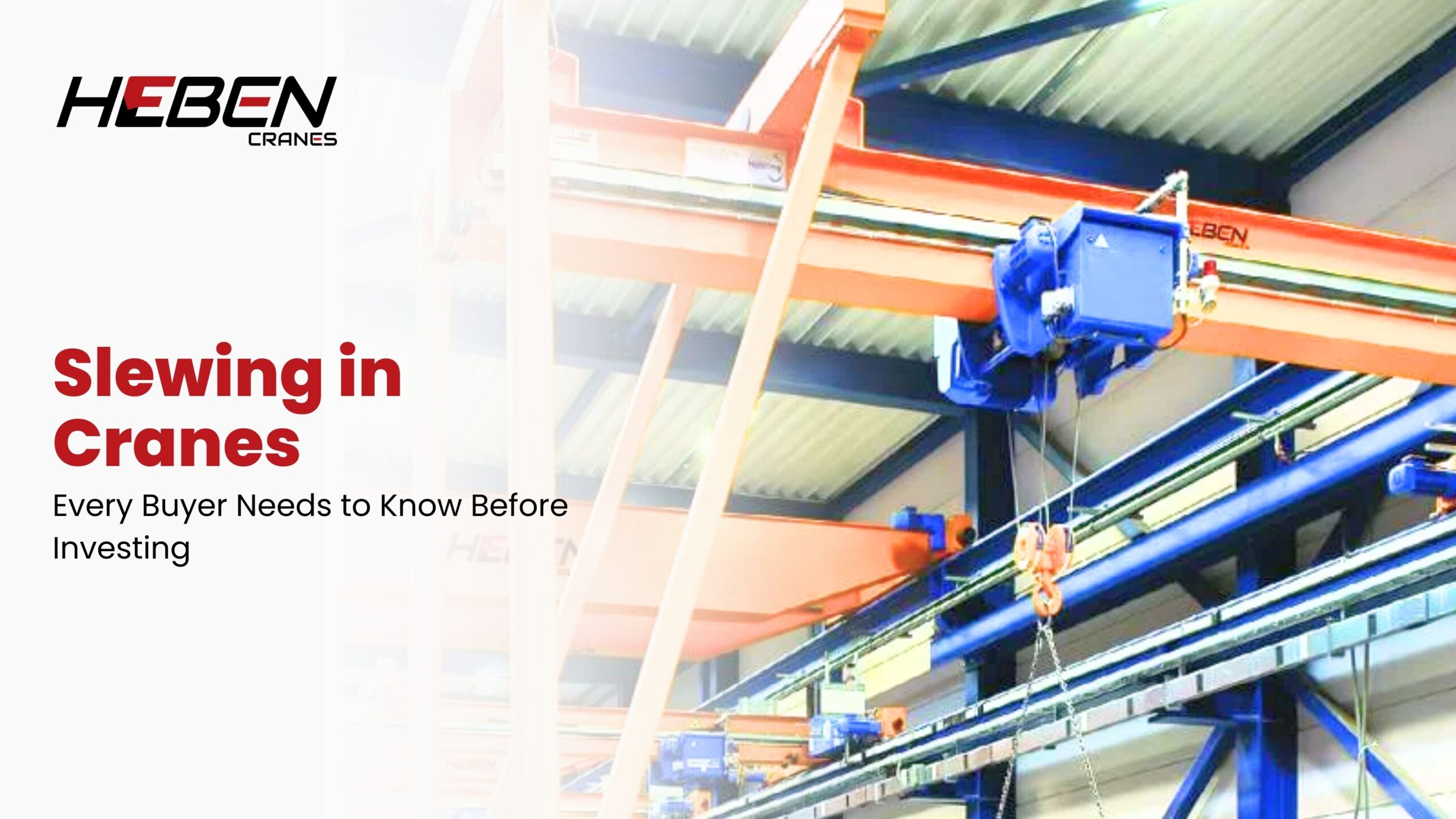The world of crane operations hinges on precise movements and reliable mechanisms, with slewing functionality standing as one of the most critical components for operational success. Understanding slewing—the rotational movement that allows cranes to position loads accurately—can mean the difference between an efficient investment and a costly mistake. This comprehensive exploration delves into the technical aspects, performance considerations, and investment factors that savvy buyers must evaluate before committing to a slewing crane system.
Introduction: The Pivotal Role of Slewing in Modern Crane Operations
Slewing cranes have revolutionized the lifting and moving capabilities across construction, shipping, and manufacturing sectors with their essential rotational functionality. This horizontal movement capability—aptly named “slewing”—enables crane operators to precisely position heavy loads without repositioning the entire machine. As defined by industry experts, slewing refers specifically to “the horizontal movement of the load and the rotation of the crane’s superstructure” around a vertical axis. This fundamental capability has transformed how industries approach complex lifting tasks.
The versatility afforded by slewing mechanisms makes these cranes indispensable in scenarios requiring precision placement of materials across construction sites, manufacturing facilities, and maritime operations. For entrepreneurs entering the heavy equipment market, understanding slewing technology isn’t just technical knowledge—it’s a competitive advantage that directly impacts project timelines, operational efficiency, and ultimately, your bottom line. The decision to invest in slewing crane technology represents not just a purchase but a strategic operational choice.
Decoding Slewing Mechanisms: Fundamentals and Functionalities
At its core, the slewing mechanism functions as the heart of rotational crane operations, enabling the superstructure to rotate on a stationary base. This critical system consists of several integrated components working in harmony. The slewing ring—a large, specialized bearing—supports the entire rotating portion of the crane while handling combined loads from multiple directions. Connected to this, the slew drive transmits torque from hydraulic motors to the slewing ring, creating the controlled rotational movement essential for precise operations.
What makes slewing particularly valuable is its contribution to operational efficiency. As industry documentation notes, “The slewing mechanism is designed to be efficient and reliable. It minimizes friction in the slewing mechanism, which results in higher slewing moment and faster operation”. This efficiency translates to smoother crane operation, elimination of jerking movements, and the ability to position loads with remarkable precision even in spatially restricted environments.
The technology behind slewing has evolved significantly, with modern systems integrating sensors and automated controls that optimize rotation speed based on load weight, wind conditions, and boom extension. This advancement represents a quantum leap from earlier mechanical systems, offering operators unprecedented control and safety margins during critical lifting operations.
Types of Slewing Systems: Comparing Top-Slewing and Bottom-Slewing Configurations
The choice between top-slewing and bottom-slewing cranes represents a critical decision point for buyers, with each configuration offering distinct advantages for different operational contexts.
Top-Slewing Cranes
Top-slewing cranes, also called “slew cranes,” feature their slewing mechanism positioned at the top of the mast section. According to industry sources, these cranes “can be erected to any height, but require a little more time and effort”. Their design includes “a slewing ring, a mast section, an undercarriage, a jib, a counter jib and a cabin for the operator”. These cranes excel in medium to high-rise construction projects requiring extended deployment periods. The rotational components include the tower top, operator’s cabin, and jib, while the base remains fixed with concrete counterweights for enhanced stability.
Bottom-Slewing Cranes
In contrast, bottom-slewing cranes feature their slewing ring positioned near the base, making them “well-known for quick and easy erecting and dismantling”. Often referred to as self-erecting slew cranes, these models are ideally suited for “low rise short-term construction projects”. Their mobility and rapid deployment capabilities make them particularly valuable for projects with tight timelines or frequently changing work sites.
The fundamental difference lies not just in physical configuration but in application suitability. Top-slewing cranes offer greater height potential and load capacity for major construction projects, while bottom-slewing models provide mobility and quick setup advantages for shorter-term applications. This distinction makes understanding your specific operational requirements essential before committing to either configuration.
Key Components of Slewing Assemblies: Bearings, Drives, and Control Systems
Slewing Bearings
Slewing bearings represent the cornerstone of any rotational crane system, designed to handle three critical types of forces simultaneously. These specialized bearings “bear both the axial and radial loads generated by lifting and moving materials, while also handling tilting moments, which arise when cranes operate under uneven or variable loads”. The most common variant—the four-point contact ball bearing—features “a single row of balls and can handle axial, radial, and tilting moment loads”, making it suitable for medium-load applications like tower and mobile cranes.
For higher precision requirements, cross roller bearings utilize “cylindrical rollers arranged at right angles to one another, which offers higher rigidity and load-bearing capacity compared to ball bearings”. These advanced bearings excel in applications demanding exceptional accuracy, such as offshore or shipboard crane operations.
Slewing Drives and Motors
The slew drive transforms power from hydraulic motors into rotational force, with modern systems featuring variable speed capability and precision control mechanisms. This component works in concert with the hydraulic motor, which serves as the power source for the entire slewing operation. The design of these systems prioritizes torque management and operational smoothness.
Control Systems
Contemporary slewing control systems integrate sophisticated electronics that monitor load conditions, wind resistance, and structural stress in real-time. These systems provide operators with intuitive interfaces while implementing safety boundaries that prevent dangerous operating conditions. Advanced models feature programmable positioning that allows operators to preset rotation endpoints for repetitive lifting tasks.
Performance Metrics: Evaluating Load Capacities, Rotation Angles, and Operational Speeds
Understanding performance metrics is crucial for matching crane capabilities to project requirements. Slewing speed—measured in degrees per minute—indicates “the speed at which the crane rotates in the horizontal direction”. This metric directly impacts operational efficiency, particularly in high-volume environments where rapid repositioning between lifts is essential.
Working radius represents another critical consideration, defined as “the horizontal distance from the center of the crane to the most important point”. This measurement significantly impacts lifting capacity, as “the lifting capacity of the crane at different radii may vary”.
Performance evaluation should consider:
- Slewing Speed: Faster speeds increase productivity but may require more sophisticated control systems
- Load Capacity: Must be evaluated at various radii and boom positions
- Operational Precision: Critical for specialized applications requiring millimeter-level accuracy
- Rotation Range: Whether the crane offers 360° continuous rotation or limited arc movement
Industry experts emphasize that these metrics should be evaluated holistically rather than in isolation. A crane offering exceptional slewing speed but limited precision may prove unsuitable for detailed assembly work, while slower rotation with superior positioning accuracy might be ideal for specialized installations.
Material Considerations: Durability and Maintenance of Slewing Components
The longevity of slewing systems depends significantly on material quality and maintenance practices. Under optimal conditions, “the service life of the slewing bearing ranges from 10,000 to 192,000 hours”, with this remarkable variance highlighting the importance of proper specification and care.
Manufacturing factors play a decisive role in durability, including “whether the diameter, quantity, ring wall thickness, effective length of rolling contact, tightness, radian and size of the raceway contact surface of the bearing rolling elements are compatible with the adapted equipment”. Material composition—particularly the quality of steel used and heat treatment processes—directly impacts bearing resilience under stress conditions.
Maintenance protocols represent perhaps the most influential factor in extending service life. Regular lubrication, torque verification of mounting bolts, and periodic inspection for signs of wear or contamination all contribute to maximizing component longevity. Implementing a preventative maintenance schedule based on operating hours rather than calendar time ensures optimal performance throughout the equipment lifecycle.
Safety Protocols: Ensuring Secure and Efficient Slewing Operations
Safety considerations for slewing operations begin with operator qualification. Industry guidelines stipulate that “only trained operators designated in writing by the company should be allowed to operate a crane”, with the crucial stipulation that training must be specific to “that particular make, model and type of crane”.
Pre-operation safety protocols demand thorough inspection before each use, following the “Daily Inspection and Startup Procedure”. During operations, load weight determination represents a non-negotiable safety requirement, as this information enables proper sling selection and configuration of the slewing mechanism.
A fundamental safety rule that applies universally: “Never leave the crane when a load is suspended”. This seemingly simple directive prevents numerous potentially catastrophic scenarios during slewing operations. Additional safety considerations include:
- Implementing wind speed monitoring systems that restrict slewing operations during high-wind conditions
- Utilizing anti-collision systems that prevent rotation into obstructions
- Installing proximity warning systems that alert operators to potential hazards
- Ensuring all personnel understand swing radius dangers during slewing operations
Technological Advancements: Smart Features and Automation in Slewing Systems
The integration of smart technology has transformed modern slewing systems, with computerized load moment indicators now standard on sophisticated models. These systems continuously calculate stability factors based on boom position, load weight, and slewing angle, automatically restricting operation when approaching safety limits.
Remote monitoring capabilities allow fleet managers to track slewing performance metrics, operational hours, and maintenance needs across multiple units simultaneously. This data-driven approach enables predictive maintenance scheduling that addresses potential issues before they cause downtime.
The most advanced systems now incorporate semi-autonomous functionality, with programmable slewing paths that can be repeated with exceptional precision. This capability proves particularly valuable in repetitive lifting scenarios, such as material transfer between fixed points or assembly line operations.
Customization Options: Tailoring Slewing Capabilities to Specific Project Needs
Modern crane manufacturers offer extensive customization possibilities to match slewing capabilities with project-specific requirements. Adaptations include specialized slewing rings with enhanced load capacities for particular applications, variable-speed drive systems that prioritize either torque or rotation speed, and customized control interfaces tailored to operator preferences.
Environmental adaptations represent another customization category, with Arctic packages featuring specialized lubricants and seals for extreme cold, maritime configurations with enhanced corrosion protection, and explosion-proof variants for hazardous environments. Each modification addresses specific operational challenges while maintaining core slewing functionality.
When evaluating customization options, buyers should consider not just immediate project needs but potential future applications. Investing in adaptable systems with expansion capabilities often proves more economical than replacing equipment as requirements evolve.
Cost-Benefit Analysis: Assessing Investment Value and Long-Term Returns
Initial acquisition cost represents just one factor in the total ownership equation for slewing crane systems. Savvy buyers evaluate lifecycle expenses including:
- Maintenance requirements and associated costs
- Operational efficiency and productivity impacts
- Versatility across different project types
- Resale value retention
- Downtime probability and associated expenses
The performance advantages of superior slewing systems often justify premium pricing through enhanced productivity. A crane capable of faster slewing speeds with more precise positioning can complete significantly more lifts per day, potentially amortizing the additional investment within months rather than years.
Reliability factors heavily in the cost-benefit calculation, with component quality directly impacting downtime probability. Given that project delays attributed to equipment failures often exceed the cost differential between standard and premium components, investing in higher-quality slewing systems frequently proves economically sound.
Conclusion: Making Informed Decisions for Optimal Crane Performance
The slewing mechanism stands as the defining feature of rotational cranes, with its capabilities directly influencing operational efficiency, safety margins, and investment return. By thoroughly understanding the mechanics, configurations, and performance metrics discussed, buyers can make informed decisions that align with their specific operational requirements and financial parameters.
The ideal slewing system balances initial investment against long-term value, with consideration for project-specific needs and future adaptability. Whether selecting a top-slewing configuration for extended high-rise construction or a bottom-slewing model for rapid deployment across multiple sites, the informed buyer recognizes that the right slewing system serves as a critical competitive advantage in today’s construction and industrial landscapes.
As slewing technology continues to evolve with enhanced automation and intelligent control systems, staying informed about emerging capabilities will enable entrepreneurs to maintain their competitive edge through strategic equipment investment decisions.





